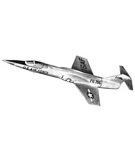 Random image Random image |
 |

F-104A STARFIGHTER
nitrocharged
|
 |
|
 |
 |
FIRECREST
| FIRECREST |
| Description: |
Reprinted from Model Aviation (UK), Feb. 1950 (p. 20)
FIRECREST is one of the few Jetex-powered models which has not followed conventional lines – that is, the high wing, pod-and-boom type with the underslung jet unit mounted in the rear of the pod. With all such layouts the line of thrust is very much below the centre of drag of the whole model, often with the result that the model is actually underelevated to prevent stalling under power. With the jet unit mounted just above the wings the line of thrust coincides, or very nearly so, with the centre of resistance so that optimum trim can be obtained both under power and on the glide. This then enables a very efficient rigging to be adopted, where the centre of gravity is moved well aft so that the tailplane is carrying part of the total load. Naturally enough, the tailplane itself is of lifting section.
Winners, 1949 ICI Jetex Trophy For the wings, a Marquardt type aerofoil section was chosen as this has proved ideal for small, lightly loaded models, combining low drag for best climb with excellent glide characteristics at lower speeds. The Firecrest, in other words, is designed along best modern duration lines and as such has a flight ratio comparable with that of most free flight power models on limited motor runs. The final design which won the I.C.I. Trophy differs from the original prototype. One of the main differences is that an underslung fin is used. The first model also had an upper fin of almost the same area, but this was not found necessary as adequate directional and spiral stability is achieved with just the bottom fin alone.
Constructionally, the Firecrest should present no difficulties to the average builder. The fuselage sides are cut from sheet and joined with 1/16" square spacers and a 1/16" sheet former (former A), as shown in the detailed sketches. The original model used hard 1/32" sheet for the sides, but light 1/16" sheet is preferable, and can work out at about the same weight, if carefully selected. Thinner sheet has a tendency to buckle or warp.
To mount the Jetex 200 unit, the standard clip is screwed to a 1 mm. ply base, which is then cemented across the top of the fuselage immediately behind former C. The span between former B and the noseblock is filled in with soft balsa block. The cockpit cover is cut down from a standard commercial bubble type canopy, reversed back to front.
To take landing loads, sheet in the first bay of the underside of the fuselage. The remainder of the top and bottom surfaces of the fuselage are then tissue covered and the whole given one coat of dope.
Construction of the wings and tailplane is straightforward. The wings are built flat in one piece and later cracked up to the required dihedral angles. Joints are strengthened by cementing the 1 mm. ply W1 and W2 members to the spars.
The Firecrest is best flown in a wide circling glide after a straight climb. Trim for glide first, having balanced the model at the design C.G. position, and add negative incidence to the tailplane, if necessary, to get the flattest glide. Try power tests with a quarter-charge, i.e. one half of a single charge. Any tendency to turn under power can be corrected with rudder, or by offsetting the Jetex unit, or a combination of both. |
| Keywords: |
firecrest jetex 200 |
| Date: |
04.01.2021 14:25 |
| Hits: |
4171 |
| Downloads: |
6 |
| Rating: |
0.00 (0 Vote(s)) |
| File size: |
43.4 KB |
| Added by: |
nitrocharged |
|
|
 |
